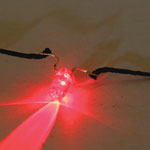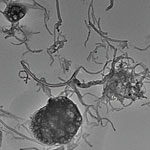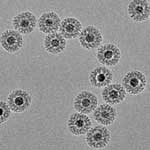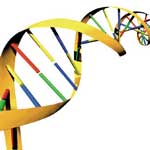Showing Spotlights 2105 - 2112 of 2783 in category All (newest first):
 If current research is an indicator, wearable electronics will go far beyond just very small electronic devices or wearable, flexible computers. Not only will these devices be embedded in textile substrates but an electronics device or system could ultimately become the fabric itself. Electronic textiles (e-textiles) will allow the design and production of a new generation of garments with distributed sensors and electronic functions. Such e-textiles will have the revolutionary ability to sense, act, store, emit, and move - think biomedical monitoring functions or new man-machine interfaces - while ideally leveraging an existing low-cost textile manufacturing infrastructure. A recent research report proposes to make conductive, carbon nanotube-modified cotton yarn. This would offer a uniquely simple yet remarkably functional solution for smart textiles - close in feel and handling to normal fabric - yet with many parameters exceeding existing solutions.
If current research is an indicator, wearable electronics will go far beyond just very small electronic devices or wearable, flexible computers. Not only will these devices be embedded in textile substrates but an electronics device or system could ultimately become the fabric itself. Electronic textiles (e-textiles) will allow the design and production of a new generation of garments with distributed sensors and electronic functions. Such e-textiles will have the revolutionary ability to sense, act, store, emit, and move - think biomedical monitoring functions or new man-machine interfaces - while ideally leveraging an existing low-cost textile manufacturing infrastructure. A recent research report proposes to make conductive, carbon nanotube-modified cotton yarn. This would offer a uniquely simple yet remarkably functional solution for smart textiles - close in feel and handling to normal fabric - yet with many parameters exceeding existing solutions.
Nov 14th, 2008
 Europe is a key player in nanotechnology. The European Commission alone, not counting the investments made by individual countries, in 2007 has invested some $720 million into European nanotechnology projects. In contrast to the U.S., much of the science and technology policy in Europe is guided by the Precautionary Principle, although critics argue that this contributes to the high level of bureaucracy and red tape that prevents European companies from speedily translating the continent's leading-edge nanotechnology research into commercial products. Activities concerning the research on environmental, health and safety (EHS) aspects of nanotechnology deal with potential risk issues and are aimed at decreasing uncertainty about potential risks and benefits on the basis of scientific knowledge, for instance research on the toxicity of nanomaterials and manufactured nanoparticles. Since developments in science and technology do not take place independently from society, European policy makers see it as important to support a dialogue on benefits and risks of nanotechnology, including ethical, legal, societal aspects (ELSA) and governance, involving great parts of the public and basing on informed judgment.
Europe is a key player in nanotechnology. The European Commission alone, not counting the investments made by individual countries, in 2007 has invested some $720 million into European nanotechnology projects. In contrast to the U.S., much of the science and technology policy in Europe is guided by the Precautionary Principle, although critics argue that this contributes to the high level of bureaucracy and red tape that prevents European companies from speedily translating the continent's leading-edge nanotechnology research into commercial products. Activities concerning the research on environmental, health and safety (EHS) aspects of nanotechnology deal with potential risk issues and are aimed at decreasing uncertainty about potential risks and benefits on the basis of scientific knowledge, for instance research on the toxicity of nanomaterials and manufactured nanoparticles. Since developments in science and technology do not take place independently from society, European policy makers see it as important to support a dialogue on benefits and risks of nanotechnology, including ethical, legal, societal aspects (ELSA) and governance, involving great parts of the public and basing on informed judgment.
Nov 13th, 2008
 Quantum dots are emerging as an important class of nanoparticles with applications ranging from medicine to energy. These nanocrystals possess size tunable optical and electronic properties resulting from quantum confinement which allow them to be suitable candidates for applications in solar cells and light emitting devices. For instance, quantum dots have been identified as important light harvesting material for building highly efficient solar cells - when exposed to light at certain wavelengths they can generate free electrons and create an electrical current. Having a high resistance to photobleaching, quantum dots (QDs) also are attractive materials for optoelectronics and in vivo biosensing. Researchers have now demonstrated that QDs, in addition to being excellent fluorescent probes, can be used as photoacoustic (which combines the advantages of optical absorption contrast with ultrasonic spatial resolution for deep imaging) and photothermal contrast agents and sensitizers, thereby providing an opportunity for multimodal high resolution photoacoustic/photothermal-fluorescent imaging as well as sensitizers in nanotherapeutic applications.
Quantum dots are emerging as an important class of nanoparticles with applications ranging from medicine to energy. These nanocrystals possess size tunable optical and electronic properties resulting from quantum confinement which allow them to be suitable candidates for applications in solar cells and light emitting devices. For instance, quantum dots have been identified as important light harvesting material for building highly efficient solar cells - when exposed to light at certain wavelengths they can generate free electrons and create an electrical current. Having a high resistance to photobleaching, quantum dots (QDs) also are attractive materials for optoelectronics and in vivo biosensing. Researchers have now demonstrated that QDs, in addition to being excellent fluorescent probes, can be used as photoacoustic (which combines the advantages of optical absorption contrast with ultrasonic spatial resolution for deep imaging) and photothermal contrast agents and sensitizers, thereby providing an opportunity for multimodal high resolution photoacoustic/photothermal-fluorescent imaging as well as sensitizers in nanotherapeutic applications.
Nov 12th, 2008
 As we have show before, nanotechnology applications could provide decisive technological breakthroughs in the energy sector and have a considerable impact on creating the sustainable energy supply that is required to make the transition from fossil fuels. Although we love to write about all the clean and green applications that will be nanotechnology enabled, the harsh reality is that dirty energy is still fuelling our way of life. No matter if you are a member of the "drill, baby, drill" crowd or if you are actively involved in saving energy and think that the development of renewable energies can't come fast enough, we have to live with the fact that the world's energy production will continue to depend on oil, gas and coal for quite a few more years. But even here, nanotechnology applications might offer some improvements. A new report shows that nanotechnology, in the form of carbon nanotube rubber composites, could help to significantly enhance oil production efficiency by allowing to probe and drill deeper wells.
As we have show before, nanotechnology applications could provide decisive technological breakthroughs in the energy sector and have a considerable impact on creating the sustainable energy supply that is required to make the transition from fossil fuels. Although we love to write about all the clean and green applications that will be nanotechnology enabled, the harsh reality is that dirty energy is still fuelling our way of life. No matter if you are a member of the "drill, baby, drill" crowd or if you are actively involved in saving energy and think that the development of renewable energies can't come fast enough, we have to live with the fact that the world's energy production will continue to depend on oil, gas and coal for quite a few more years. But even here, nanotechnology applications might offer some improvements. A new report shows that nanotechnology, in the form of carbon nanotube rubber composites, could help to significantly enhance oil production efficiency by allowing to probe and drill deeper wells.
Nov 11th, 2008
 The toxicity issues surrounding carbon nanotubes (CNTs) are highly relevant for two reasons: Firstly, as more and more products containing CNTs come to market, there is a chance that free CNTs get released during their life cycles, most likely during production or disposal, and find their way through the environment into the body. Secondly, and much more pertinent with regard to potential health risks, is the use of CNTs in biological and medical settings. CNTs interesting structural, chemical, electrical, and optical properties are explored by numerous nanomedicine research groups around the world with the goal of drastically improving performance and efficacy of biological detection, imaging, and therapy applications. In many of these envisaged applications, CNTs would be deliberately injected or implanted in the body. While it has been shown that carbon nanotubes can indeed act as a means for drug delivery, negative effects such as unusual and robust inflammatory response, oxidative stress and formation of free radicals, and the accumulation of peroxidative products have also been found as a result of carbon nanotubes and their accumulated aggregates. As a possible solution, scientists have provided compelling evidence of the biodegradation of carbon nanotubes by horseradish peroxidase and hydrogen peroxide over the period of several weeks. This marks a promising possibility for nanotubes to be degraded by horseradish peroxidase in environmentally relevant settings.
The toxicity issues surrounding carbon nanotubes (CNTs) are highly relevant for two reasons: Firstly, as more and more products containing CNTs come to market, there is a chance that free CNTs get released during their life cycles, most likely during production or disposal, and find their way through the environment into the body. Secondly, and much more pertinent with regard to potential health risks, is the use of CNTs in biological and medical settings. CNTs interesting structural, chemical, electrical, and optical properties are explored by numerous nanomedicine research groups around the world with the goal of drastically improving performance and efficacy of biological detection, imaging, and therapy applications. In many of these envisaged applications, CNTs would be deliberately injected or implanted in the body. While it has been shown that carbon nanotubes can indeed act as a means for drug delivery, negative effects such as unusual and robust inflammatory response, oxidative stress and formation of free radicals, and the accumulation of peroxidative products have also been found as a result of carbon nanotubes and their accumulated aggregates. As a possible solution, scientists have provided compelling evidence of the biodegradation of carbon nanotubes by horseradish peroxidase and hydrogen peroxide over the period of several weeks. This marks a promising possibility for nanotubes to be degraded by horseradish peroxidase in environmentally relevant settings.
Nov 10th, 2008
 Developed originally for the surface finishing industry, diamond nanoparticles are now finding new and far-reaching applications in modern biomedical science and biotechnologies. Due to its excellent biocompatibility, diamond has been called the Biomaterial of the 21st Century and medical diamond coatings are already heavily researched for implants and prostheses. Nanoscale diamond is also being discussed as a promising cellular biomarker and a non-toxic alternative to heavy metal quantum dots. Further extending the nanomedical use of diamond, researchers now have demonstrated a nanodiamond-embedded device that could be used to deliver chemotherapy drugs locally to sites where cancerous tumors have been surgically removed.
Developed originally for the surface finishing industry, diamond nanoparticles are now finding new and far-reaching applications in modern biomedical science and biotechnologies. Due to its excellent biocompatibility, diamond has been called the Biomaterial of the 21st Century and medical diamond coatings are already heavily researched for implants and prostheses. Nanoscale diamond is also being discussed as a promising cellular biomarker and a non-toxic alternative to heavy metal quantum dots. Further extending the nanomedical use of diamond, researchers now have demonstrated a nanodiamond-embedded device that could be used to deliver chemotherapy drugs locally to sites where cancerous tumors have been surgically removed.
Nov 7th, 2008
 Mesoporous materials, i.e. materials with pores that measure less than 50 nanometers in size, have been researched extensively for at least 20 years now. Especially mesoporous silicates, due to their large surface area, their uniform pore size, and the accessibility of these pores, have become very popular as catalyst materials and excellent dug delivery candidates. Despite of the long research history of mesoporous silica materials and their biomedical potential, there have been only few reports on actual in vivo applications. Although the theory looks good, there are several practical obstacles for mesoporous silica materials to be used as drug carriers or for instance as in vivo cancer targeting agents. Researchers who tried making small mesoporous silica particles with sizes of around 100 nm often ended up with much larger lumps of aggregated particles. These larger chunks cannot be used because, due to their size, they are easily trapped in the body's defense mechanism, the reticuloendothelial system (RES). Researchers in South Korea have now reported the fabrication of discrete, monodisperse, and precisely size-controllable core?shell nanoparticles that are smaller than 100 nm, by using single magnetite nanocrystals as core and a mesoporous silica shell.
Mesoporous materials, i.e. materials with pores that measure less than 50 nanometers in size, have been researched extensively for at least 20 years now. Especially mesoporous silicates, due to their large surface area, their uniform pore size, and the accessibility of these pores, have become very popular as catalyst materials and excellent dug delivery candidates. Despite of the long research history of mesoporous silica materials and their biomedical potential, there have been only few reports on actual in vivo applications. Although the theory looks good, there are several practical obstacles for mesoporous silica materials to be used as drug carriers or for instance as in vivo cancer targeting agents. Researchers who tried making small mesoporous silica particles with sizes of around 100 nm often ended up with much larger lumps of aggregated particles. These larger chunks cannot be used because, due to their size, they are easily trapped in the body's defense mechanism, the reticuloendothelial system (RES). Researchers in South Korea have now reported the fabrication of discrete, monodisperse, and precisely size-controllable core?shell nanoparticles that are smaller than 100 nm, by using single magnetite nanocrystals as core and a mesoporous silica shell.
Nov 6th, 2008
 DNA, the fundamental building block of our genetic makeup, has become an intense nanotechnology research field. DNA molecules can serve as precisely controllable and programmable scaffolds for organizing functional nanomaterials in the design, fabrication, and characterization of nanometer scale electronic devices and sensors. The reason why DNA could be useful in nanotechnology for the design of electric circuits is the fact that it actually is the best nanowire in existence - it self-assembles, it self-replicates and it can adopt various states and conformations. The most basic and simplest form of DNA mechanical devices that are expected to be the first to demonstrate some close-to-reality functions are DNA tweezers. This concept was first introduced in 2000 by scientists at Bell Labs and Oxford University. To keep this type of tweezers running, two fuel DNA strands are alternately added to a buffered solution that contains the tweezers. These fuels are basically two stretches of complementary DNA, one of which closes the tweezers and the other opens them. The exciting potential applications for DNA tweezers include their use in constructing various molecular devices dedicated to repairing a functional unit in a cell, harnessing the delivery of drug molecules to pathogenic cells, or assembling nanoscale devices.
DNA, the fundamental building block of our genetic makeup, has become an intense nanotechnology research field. DNA molecules can serve as precisely controllable and programmable scaffolds for organizing functional nanomaterials in the design, fabrication, and characterization of nanometer scale electronic devices and sensors. The reason why DNA could be useful in nanotechnology for the design of electric circuits is the fact that it actually is the best nanowire in existence - it self-assembles, it self-replicates and it can adopt various states and conformations. The most basic and simplest form of DNA mechanical devices that are expected to be the first to demonstrate some close-to-reality functions are DNA tweezers. This concept was first introduced in 2000 by scientists at Bell Labs and Oxford University. To keep this type of tweezers running, two fuel DNA strands are alternately added to a buffered solution that contains the tweezers. These fuels are basically two stretches of complementary DNA, one of which closes the tweezers and the other opens them. The exciting potential applications for DNA tweezers include their use in constructing various molecular devices dedicated to repairing a functional unit in a cell, harnessing the delivery of drug molecules to pathogenic cells, or assembling nanoscale devices.
Nov 5th, 2008
 If current research is an indicator, wearable electronics will go far beyond just very small electronic devices or wearable, flexible computers. Not only will these devices be embedded in textile substrates but an electronics device or system could ultimately become the fabric itself. Electronic textiles (e-textiles) will allow the design and production of a new generation of garments with distributed sensors and electronic functions. Such e-textiles will have the revolutionary ability to sense, act, store, emit, and move - think biomedical monitoring functions or new man-machine interfaces - while ideally leveraging an existing low-cost textile manufacturing infrastructure. A recent research report proposes to make conductive, carbon nanotube-modified cotton yarn. This would offer a uniquely simple yet remarkably functional solution for smart textiles - close in feel and handling to normal fabric - yet with many parameters exceeding existing solutions.
If current research is an indicator, wearable electronics will go far beyond just very small electronic devices or wearable, flexible computers. Not only will these devices be embedded in textile substrates but an electronics device or system could ultimately become the fabric itself. Electronic textiles (e-textiles) will allow the design and production of a new generation of garments with distributed sensors and electronic functions. Such e-textiles will have the revolutionary ability to sense, act, store, emit, and move - think biomedical monitoring functions or new man-machine interfaces - while ideally leveraging an existing low-cost textile manufacturing infrastructure. A recent research report proposes to make conductive, carbon nanotube-modified cotton yarn. This would offer a uniquely simple yet remarkably functional solution for smart textiles - close in feel and handling to normal fabric - yet with many parameters exceeding existing solutions.

 Subscribe to our Nanotechnology Spotlight feed
Subscribe to our Nanotechnology Spotlight feed





